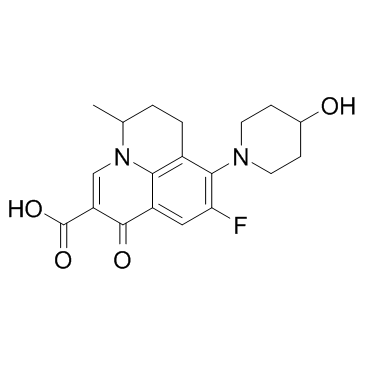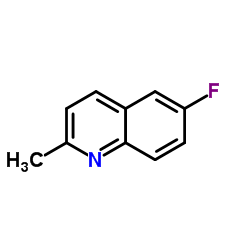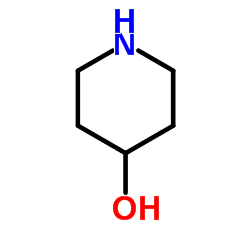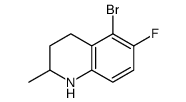Nadifloxacin

Nadifloxacin structure
|
Common Name | Nadifloxacin | ||
|---|---|---|---|---|
| CAS Number | 124858-35-1 | Molecular Weight | 360.379 | |
| Density | 1.5±0.1 g/cm3 | Boiling Point | 624.9±55.0 °C at 760 mmHg | |
| Molecular Formula | C19H21FN2O4 | Melting Point | 245-247ºC (dec) | |
| MSDS | Chinese USA | Flash Point | 331.7±31.5 °C | |
Use of NadifloxacinNadifloxacin(OPC7251) is a topical fluoroquinolone antibiotic for the treatment of acne vulgaris. Target: AntibacterialNadifloxacin is a potent, broad-spectrum, quinolone agent approved for topical use in acne vulgaris and skin infections. Nadifloxacin inhibits the enzyme DNA gyrase that is involved in bacterial DNA synthesis and replication, thus inhibiting the bacterial multiplication. In vitro studies of nadifloxacin show potent and broad-spectrum antibacterial activity against aerobic Gram-positive, Gram-negative and anaerobic bacteria. Additionally, studies also suggest that the effectiveness of nadifloxacin in inflammatory acne lesions may be attributed to its inhibitory effect on pro-inflammatory cytokines like interleukin (IL)-1α, IL-6, and IL-8 which also play an important role in acne pathogenesis [1, 2]. |
| Name | nadifloxacin |
|---|---|
| Synonym | More Synonyms |
| Description | Nadifloxacin(OPC7251) is a topical fluoroquinolone antibiotic for the treatment of acne vulgaris. Target: AntibacterialNadifloxacin is a potent, broad-spectrum, quinolone agent approved for topical use in acne vulgaris and skin infections. Nadifloxacin inhibits the enzyme DNA gyrase that is involved in bacterial DNA synthesis and replication, thus inhibiting the bacterial multiplication. In vitro studies of nadifloxacin show potent and broad-spectrum antibacterial activity against aerobic Gram-positive, Gram-negative and anaerobic bacteria. Additionally, studies also suggest that the effectiveness of nadifloxacin in inflammatory acne lesions may be attributed to its inhibitory effect on pro-inflammatory cytokines like interleukin (IL)-1α, IL-6, and IL-8 which also play an important role in acne pathogenesis [1, 2]. |
|---|---|
| Related Catalog | |
| References |
| Density | 1.5±0.1 g/cm3 |
|---|---|
| Boiling Point | 624.9±55.0 °C at 760 mmHg |
| Melting Point | 245-247ºC (dec) |
| Molecular Formula | C19H21FN2O4 |
| Molecular Weight | 360.379 |
| Flash Point | 331.7±31.5 °C |
| Exact Mass | 360.148529 |
| PSA | 82.77000 |
| LogP | 1.95 |
| Vapour Pressure | 0.0±1.9 mmHg at 25°C |
| Index of Refraction | 1.669 |
| Storage condition | -20?C Freezer |
| RIDADR | NONH for all modes of transport |
|---|
|
~% 
Nadifloxacin CAS#:124858-35-1 |
| Literature: Chemical and Pharmaceutical Bulletin, , vol. 37, # 8 p. 2103 - 2108 |
|
~% 
Nadifloxacin CAS#:124858-35-1 |
| Literature: Chemical and Pharmaceutical Bulletin, , vol. 37, # 8 p. 2103 - 2108 |
|
~24% 
Nadifloxacin CAS#:124858-35-1 |
| Literature: Chemical and Pharmaceutical Bulletin, , vol. 37, # 8 p. 2103 - 2108 |
|
~% 
Nadifloxacin CAS#:124858-35-1 |
| Literature: Chemical and Pharmaceutical Bulletin, , vol. 37, # 8 p. 2103 - 2108 |
|
Efficacy and safety of nadifloxacin for bacterial skin infections: results from clinical and post-marketing studies.
Dermatol. Ther. (Heidelb.) 4(2) , 233-48, (2014) Skin and soft tissue infections involve microbial invasion of the skin and underlying soft tissues and are estimated to affect 7-10% of hospitalized patients worldwide. Nadifloxacin, a topical fluoroq... |
|
|
Green Nail Syndrome (Pseudomonas aeruginosa Nail Infection): Two Cases Successfully Treated with Topical Nadifloxacin, an Acne Medication.
Case Rep. Dermatol. 6(2) , 180-4, (2014) Green nail syndrome (GNS) caused by Pseudomonas aeruginosa is the most common bacterial nail infection. The treatment of GNS is challenging in many cases and recommendations based on clinical trials a... |
|
|
Design and evaluation of microemulsion gel system of nadifloxacin.
Indian J. Pharm. Sci. 74(3) , 237-47, (2012) Topical microemulsion systems for the antiacne agent, nadifloxacin were designed and developed to overcome the problems associated with the cutaneous delivery due to poor water solubility. The solubil... |
| 9-Fluoro-8-(4-hydroxy-1-piperidinyl)-5-methyl-1-oxo-6,7-dihydro-1H,5H-pyrido[3,2,1-ij]quinoline-2-carboxylic acid |
| (±)-9-Fluoro-6,7-dihydro-8-(4-hydroxy-1-piperidinyl)-5-methyl-1-oxo-1H,5H-benzo[ij]quinolizine-2-carboxylic Acid |
| Nadiflox |
| Activon |
| 1H,5H-Benzo[ij]quinolizine-2-carboxylic acid, 9-fluoro-6,7-dihydro-8-(4-hydroxy-1-piperidinyl)-5-methyl-1-oxo- |
| Acuatim |
| Jinofloxacin |
| Nadifloxacin |
| 9-Fluoro-8-(4-hydroxypiperidin-1-yl)-5-methyl-1-oxo-6,7-dihydro-1H,5H-pyrido[3,2,1-ij]quinoline-2-carboxylic acid |
| Nadixa |
| Nadoxin |
| MFCD00865081 |



![9-fluoro-8-bromo-5-methyl-6,7-dihydro-1-oxo-1H,5H-benzo[ij]quinolizine-2-carboxylic acid structure](https://image.chemsrc.com/caspic/472/77483-92-2.png)
